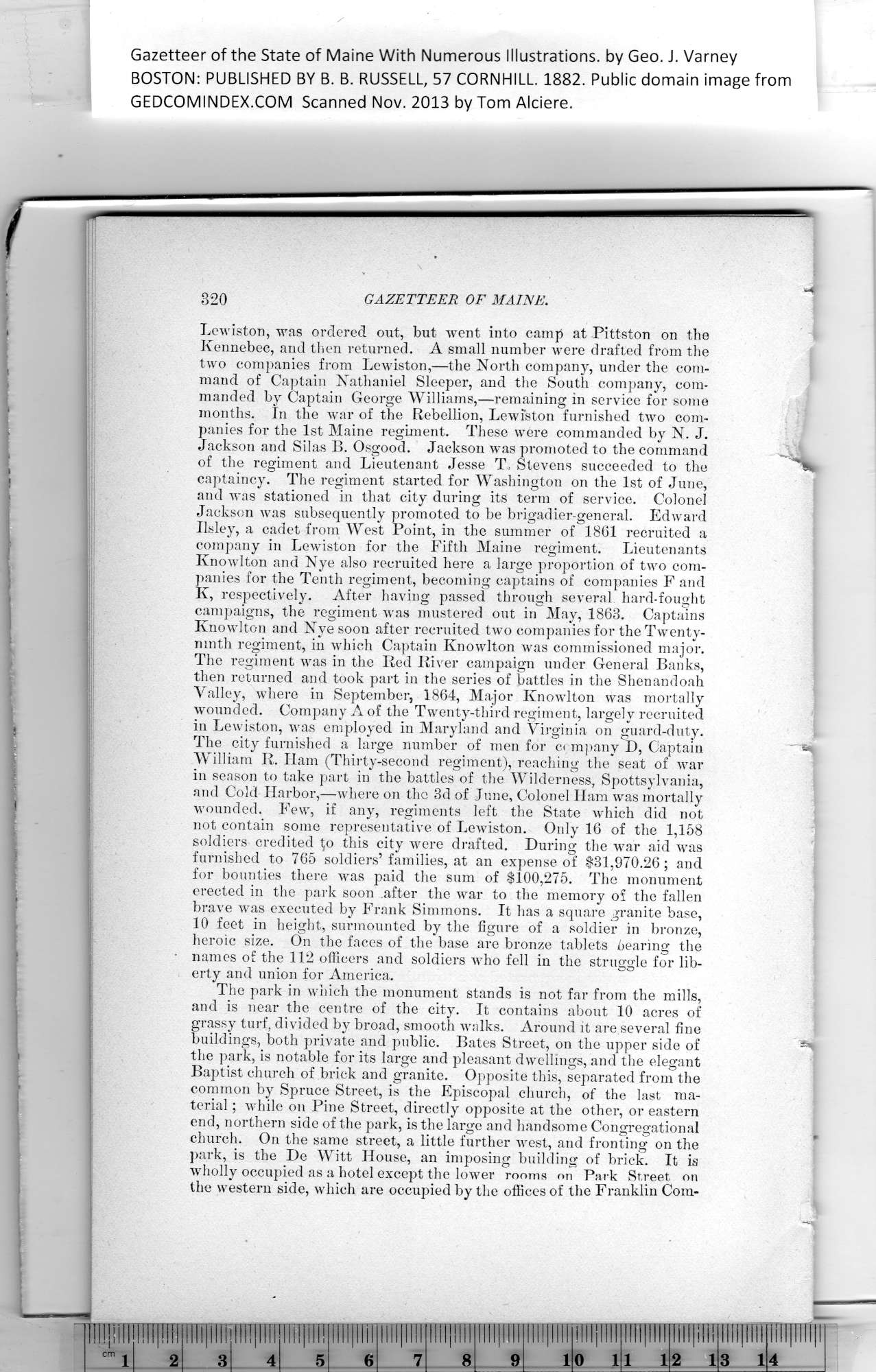|
Gazetteer of the State of Maine With Numerous Illustrations, by Geo. J. Varney
BOSTON: PUBLISHED BY B. B. RUSSELL, 57 CORNHILL. 1882. Public domain image from
820 GAZETTEER OF MAINE
Lewiston, was ordered out, but went into camp at Pittston on the
Kennebec, and then returned. A small number were drafted from the
two companies from Lewiston,—the North company, under the com-
mand of Captain Nathaniel Sleeper, and the South company, com-
manded by Captain George Williams,—remaining in service for some
months. In the war of the Rebellion, Lewiston furnished two com-
panies for the 1st Maine regiment. These were commanded by N. J.
Jackson and Silas B. Osgood. Jackson was promoted to the command _
of the regiment and Lieutenant Jesse T„ Stevens succeeded to the "SV.
captaincy. The regiment started for Washington on the 1st of June,
and was stationed in that city during its term of service. Colonel
Jackson was subsequently promoted to be brigadier-general. Edward
Ilsley, a cadet from West Point, in the summer of 1861 recruited a
company in Lewiston for the Fifth Maine regiment. Lieutenants
Knowlton and Nye also recruited here a large proportion of two com-
panies for the Tenth regiment, becoming captains of companies F and
K, respectively. After having passed through several hard-fought
campaigns, the regiment was mustered out in May, 1863. Captains
Knowlton and Nye soon after recruited two companies for the Twenty-
ninth regiment, in which Captain Knowlton was commissioned major.
The regiment was in the Red River campaign under General Banks,
then returned and took part in the series of battles in the Shenandoah
Valley, -where in September, 1864, Major Knowlton was mortally
wounded. Company A of the Twenty-third regiment, largely recruited
in Lewiston, was employed in Maryland and Virginia on guard-duty.
The city furnished a large number of men for company D, Captain
William R. Ham (Thirty-second regiment), reaching the seat of war
in season to take part in the battles of the Wilderness, Spottsylvania,
and Cold Harbor,—where on the 3d of June, Colonel Ham was mortally
wounded. Few, if any, regiments left the State which did not
not contain some representative of Lewiston. Only 16 of the 1,158
soldiers credited to this city were drafted. During the war aid was
furnished to 765 soldiers’families, at an expense of $31,970.26; and
for bounties there was paid the sum of $100,275. The monument
erected in the park soon after the war to the memory of the fallen
brave was executed by Frank Simmons. It has a square granite base,
10 feet in height, surmounted by the figure of a soldier in bronze,
heroic size. On the faces of the base are bronze tablets hearing the
names of the 112 officers and soldiers who fell in the struggle for lib-
erty and union for America.
The park in which the monument stands is not far from the mills,
and is near the centre of the city. It contains about 10 acres of
grassy turf, divided by broad, smooth walks. Around it are several fine
buildings, both private and public. Bates Street, on the upper side of
the park, is notable for its large and pleasant dwellings, and the elegant
Baptist church of brick and granite. Opposite this, separated from the
common by Spruce Street, is the Episcopal church, of the last ma-
terial ; while on Pine Street, directly opposite at the other, or eastern
end, northern side of the park, is the large and handsome Congregational
church. On the same street, a little further west, and fronting on the
park, is the De Witt House, an imposing building of brick. It is
wholly occupied as a hotel except the lower rooms on Park Street on
the western side, which are occupied by the offices of the Franklin Com-
PREVIOUS PAGE ... NEXT PAGE
This page was written in HTML using a program written in Python 3.2
|
